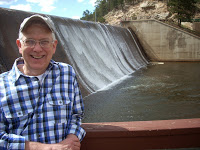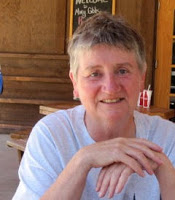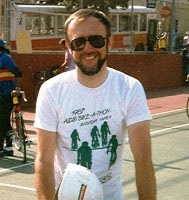Group Grief, by Phillip Hoyle
Dancing with the Stars, by Gillian
I won’t be. Dancing with the stars, that is. No matter how they beg, I will not be on that show. Not, I must confess, that I have ever watched it; but I get the concept. Star-worship is just not something that has ever been in me. Living through the height of the fan-club phase, I never even thought of joining one. There are very few famous people I would cross the street to meet. It’s not that I have anything against the rich and famous and fabulously good-looking. It’s simply that they hold no fascination for me just because they are household names. Every one of us in this room has a life story that is every bit as fascinating, in it’s own way, as theirs.
Perhaps my attitude originated in my essentially TV- and movie-free childhood. I had little temptation to idolize. Or maybe it stems from my parents’ attitude towards the stars of the day: royalty, bigwigs in the Church of England hierarchy, the local landed gentry. They must always be spoken to politely, and that was where it ended. They would be respected when they earned respect. We were every bit as good as they were and there would be no figurative bowing and doffing of caps. This was a burgeoning feeling in England in the 1940’s and ’50’s when the winds of equality were blowing strong. So, when I was about twelve and Princess Margaret was to visit our school, I was a little apprehensive over my mother’s reaction to the fact that we were all taught, in some detail, the correct way to bow and curtsey, and were expected to do so. But, somewhat to my surprise, Mum was fine with it. Apparently there were certain protocols she was willing to go along with. What mattered, she explained, was not so much external expressions of deference as internal knowledge of equality. A wise woman in many ways, my mother.
What I do value is dancing with the real stars; those of the firmament, sparkling and dancing above our heads. In the days of our youth, the world was not subjected to the vast explosions of artificial light which afflict it today. In my youth we had no electricity where we lived, and no form of outdoor lighting for many miles. On a rare clear English night, often also a cold one, Mom and I would lie on our backs on the lawn, usually huddled under a blanket, and she would point out constellations to me and relate their mythical stories. She only knew a few of the commonly-familiar ones, so the rest she made up and created stories to fit the shapes she saw. Half the time I couldn’t see what she saw, it was harder than one of her other favorite pastimes of agreeing on what clouds looked like, but I went along with her imagination to hear her inventive stories. My mother was just fine as long as she remained far from any form of reality.
In college in the north of England, long before the cities overgrew the hills as they have now, a group of us sometimes went up on the dark moorlands to stargaze. We always spent a couple of hours in the pub on the way, so our imaginings were rarely inhibited.
I have stared in wonder at the starry sky above Australia, South America, and South Africa. There is something very special about the night skies of the Southern Hemisphere. The stars somehow seem so much more numerous, and so much closer than we are used to. They take my breath away.
During the twenty-five years that Betsy and I camped all over this country in out VW van, we frequently danced with the stars. Many camping spots, especially National Forest Campgrounds, are about as far as you can get from city lights these days, and perfect for communing with the heavens. For some strange reason which we never did figure out, nine times out of ten, wherever we camped, The Big Dipper appeared at night to be clearly seen from our back window. Rarely the front, hardly ever the side windows, but almost inevitably if we woke in the middle of the night there was the Dipper, above us as we lay with our heads right below the back window.
We liked to settle in well before dark, so had no idea where the Dipper would be when we chose the site and decided exactly how to park for the night. We actually never thought about it. Yet there it would be, in the night, almost as regular as clockwork.
At Randy Wren’s funeral last week, his Rector said,
“Randy lived large.”
He did. If you have any belief in an afterlife in any form, you have to think that Randy is dancing with the stars; whatever that means to you. If anyone can do it, Randy can.
Once upon a time, Frank Sinatra crooned a popular song about the stars.
It went on a couple of lines later,
As long as I have My Beautiful Betsy to hold my hand and kiss me, I shall forever dance with the stars.
© July 2017
About the Author
I was born and raised in England. After graduation from college there, I moved to the U.S. and, having discovered Colorado, never left. I have lived in the Denver-Boulder area since 1965, working for 30 years at IBM. I married, raised four stepchildren, then got divorced after finally, in my forties, accepting myself as a lesbian. I have been with my wonderful partner Betsy for thirty years. We have been married since 2013.
True Colors, by Nicholas
Take a Walk in the Grove
The Grove started with one man’s vision. Doug McNeil knew of the memorial grove in Golden Gate Park in San Francisco and asked, literally as his dying wish, why can’t Denver create such a spot. Doug died of AIDS in 1993, a time when the LGBT community was focused more on the battle to undo the infamous Amendment 2 than on the AIDS epidemic. Amendment 2, passed by Colorado voters in 1992, prohibited any government or government agency in this state from enacting any provisions to ban discrimination against lesbian and gay people. (There’s an excellent exhibition on that history outside this door in The Center’s lobby.) And it was a time of still rampant AIDS phobia.
A small group of Doug’s friends vowed to carry out his dream for The Grove. They weren’t the usual gaggle of community activists and politicos. They included socialites, arts community supporters, an attorney, and an Episcopal priest. Most were not gay. They organized a non-profit group called The Grove Project, got 501c3 IRS status so they could collect funds, and began the long process of taking on the bureaucracy of the city’s Parks Department.
The Parks Department never openly rejected the idea but negotiations dragged on for years. At first, the area in front of the performing arts complex on Speer Blvd was proposed. The city objected that theatre and concert goers wouldn’t want to be reminded of the awfulness of AIDS on their nights out on the town. Another location in a park in southeast Denver was suggested but that would have left the memorial far from the Capitol Hill neighborhood that was most affected by AIDS.
At some point, the riverfront came into the discussion. At that time, the area was just beginning to be developed. There was a quiet, somewhat out of the way spot in a new park—Commons Park—that the city was planning. That fit the criteria of being visible, centrally located and quiet enough to promote the atmosphere desired.
The Grove was envisioned to be a natural area for contemplation. It was landscaped very simply with trees, natural grasses and shrubs, and some rocks. A simple inscription reads: “Dedicated to the remembrance of those who have lost their lives to AIDS and to their loving caregivers who helped them live out those lives with dignity.”
The Grove was dedicated in a simple ceremony in August 2000. Doug McNeil’s loyal and persistent friends accomplished his dream after seven years of work.
Now, The Grove sits largely ignored and sort of neglected in a recessed corner of Commons Park, near 15th Street and Little Raven Street. It is surrounded by high priced condos and apartments but it is still a quiet and attractive area.
Recently, a movement got underway to renew the spot, clean it up, refresh the landscaping and, most importantly, make the community aware that this historical and spiritual resource exists. In recalling all the individuals who battled, and continue to battle AIDS, we remember how our community grew from that experience. We remember those we’ve lost. We remember when being gay changed from just giving the most fabulous parties to a truly mature community of caregivers and advocates. We remember our past and that we have a history. A history that is the root of our present and future.
I encourage everyone to seek out The Grove and spend a few quiet moments there remembering. And maybe you can help in its renewal. You too can show your true colors.
© 2016
True Colors – Take a Walk in the Grove, by Nicholas
a member of this group. It’s about a group of people who showed their true
colors in their loyalty to one friend and created a unique space for our entire
community. Along the South Platte River on the edge of downtown Denver, is an
area of Commons Park designated as a spot to remember those who have died of
HIV/AIDS and their caregivers. It’s called The Grove and it is one of only two
AIDS memorial gardens in this country—the other is in San Francisco. Our own
Randy Wren was part of that group that labored for seven years to make it
happen.
of the memorial grove in Golden Gate Park in San Francisco and asked, literally
as his dying wish, why can’t Denver create such a spot. Doug died of AIDS in
1993, a time when the LGBT community was focused more on the battle to undo the
infamous Amendment 2 than on the AIDS epidemic. Amendment 2, passed by Colorado
voters in 1992, prohibited any government or government agency in this state
from enacting any provisions to ban discrimination against lesbian and gay
people. (There’s an excellent exhibition on that history outside this door in
The Center’s lobby.) And it was a time of still rampant AIDS phobia.
for The Grove. They weren’t the usual gaggle of community activists and
politicos. They included socialites, arts community supporters, an attorney,
and an Episcopal priest. Most were not gay. They organized a non-profit group
called The Grove Project, got 501c3 IRS status so they could collect funds, and
began the long process of taking on the bureaucracy of the city’s Parks
Department.
negotiations dragged on for years. At first, the area in front of the
performing arts complex on Speer Blvd was proposed. The city objected that
theatre and concert goers wouldn’t want to be reminded of the awfulness of AIDS
on their nights out on the town. Another location in a park in southeast Denver
was suggested but that would have left the memorial far from the Capitol Hill
neighborhood that was most affected by AIDS.
that time, the area was just beginning to be developed. There was a quiet,
somewhat out of the way spot in a new park—Commons Park—that the city was
planning. That fit the criteria of being visible, centrally located and quiet
enough to promote the atmosphere desired.
contemplation. It was landscaped very simply with trees, natural grasses and
shrubs, and some rocks. A simple inscription reads: “Dedicated to the
remembrance of those who have lost their lives to AIDS and to their loving
caregivers who helped them live out those lives with dignity.”
2000. Doug McNeil’s loyal and persistent friends accomplished his dream after
seven years of work.
in a recessed corner of Commons Park, near 15th Street and Little
Raven Street. It is surrounded by high priced condos and apartments but it is
still a quiet and attractive area.
it up, refresh the landscaping and, most importantly, make the community aware
that this historical and spiritual resource exists. In recalling all the
individuals who battled, and continue to battle AIDS, we remember how our community
grew from that experience. We remember those we’ve lost. We remember when being
gay changed from just giving the most fabulous parties to a truly mature
community of caregivers and advocates. We remember our past and that we have a
history. A history that is the root of our present and future.
quiet moments there remembering. And maybe you can help in its renewal. You too
can show your true colors.
the Author
then grew up in San Francisco, and is now growing up in Denver. He retired from
work with non-profits in 2009 and now bicycles, gardens, cooks, does yoga,
writes stories, and loves to go out for coffee.




